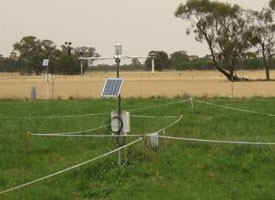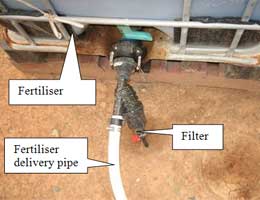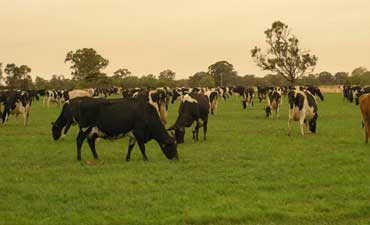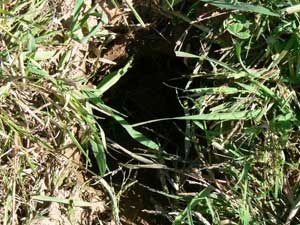Step 4.3.4 - How do I manage the system?
Back to - Step 4.3 - What needs to be considered in the planning, design, cost and management of subsurface drip irrigation (SDI)?
The efficient management of SDI can save a substantial volume of water and increase production. Here we discuss some management aspects specific to SDI that growers should consider.
4.3.4.1 When do I irrigate and how much water do I apply?
If you are planning to make the investment in SDI, it makes sense to work out how to exploit its advantages, and one of the great advantages of pressurised irrigation systems such as SDI is their potential to supply fairly precise amounts of water to plants as they require it. Irrigation scheduling methods aim to apply the right amount of water to the crop at the right time.
There are two main objective approaches employed, one based on estimating the crop evapotranspiration (ET) and applying sufficient irrigation to replace the water consumed, the other employing soil moisture monitoring sensors to measure water depletion in the soil profile, using this information to trigger irrigations. A third objective approach, still largely limited to research applications is remote sensing to measure plant response to water stress as a means to schedule irrigation. In practice these approaches, while getting better all the time, still have limitations. The fourth and most common approach is irrigators' subjective judgment and experience to schedule irrigations, based on the current appearance of the crop, the weather and predicted weather conditions.
ET methods use weather data to estimate potential evapotranspiration, then rely on estimated crop factors based on crop type and stage of growth to arrive at an estimate of actual ET. Data for potential ET is available for a large number of regional locations from the Bureau of Meteorology website (external link). For further detail about ET and the estimation of actual ET, see FAO Irrigation and Drainage paper 56 “Crop evapotranspiration-Guidelines for computing crop water requirements” (external link) published in 1998. The ET approach has proved to be very reliable for irrigation scheduling of traditional surface irrigation systems and can be used in a straightforward way in conjunction with daily measurement of evaporation from a standard Class A evaporation pan, or equivalent weather station data (Figure 19, Figure 20) modified by a pan coefficient to provide a simple estimate of potential ET. Recent developments in the application of remote sensing in the science of crop water use will provide new tools that allow reliable, cost effective, real time monitoring of actual crop ET.
The most effective irrigation scheduling still resides with irrigators experience. In the case of SDI however, where irrigation can be very precisely applied, and is applied below the surface, growers' subjective assessments will benefit from supporting objective information provided by well configured ET and/or soil moisture monitoring systems, supplemented by objective and reliable weather forecast information.
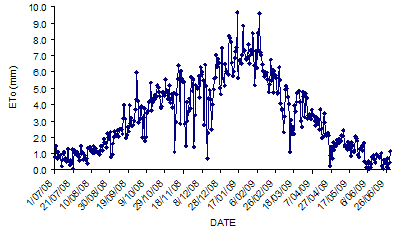
Figure 20. Daily reference ET (mm) for 2008-09 at the SDI pasture experiment, northern Victoria
4.3.4.2 How can I manage fertiliser application?
SDI provides new issues for fertiliser management. Because irrigation is delivered to the crop rootzone, traditional top dressing applications will require rainfall if they need to be watered in, which may constrain management options. SDI however also provides opportunities by allowing fertigation, which is the application of fertiliser directly to the rootzone with the irrigation. A range of fertilisers are available from suppliers, ready mixed for use. A potential risk with fertigation is the clogging of emitters from either undissolved chemical or precipitates. Ensuring the fertiliser is completely dissolved before injection will prevent clogging and variable concentration of applied fertiliser. A filter on the fertiliser tank delivery pipe can ensure that particulates in the fertiliser mix do not enter the SDI system (Figure 21). The mixing of fertilisers can pose risks of chemical reactions that cause precipitation of insoluble compounds and clogging of emitters. A fertiliser solubility table published by Water for 'Profit' outlines the compatibility of different combinations of fertiliser compounds.
4.3.4.3 How do I manage grazing?
The grazing (Figure 22) is a critical management issue in SDI of pasture. Grazing immediately after heavy irrigation or rainfall can cause pugging (Figure 23) of soil by stock and must be avoided. Pugging of saturated soil and consequent damage to drip tapes can lead to further tape damage. Leak detection is therefore critical. Once damage occurs, stock can displace driplines by stepping directly on exposed or poorly protected tapes. Results from two SDI trials in northern Victoria on loam and fine sandy loam soils concluded that grazing by cows should be avoided for at least forty eight hours following a 24-32 mm irrigation, while for a 10 mm irrigation, a minimum 12 hour interval was appropriate.
For more information see the DPI Information note:
Managing Wet Soils: Grazing Techniques
Managing Wet Soils: On-Off Grazingg
4.3.4.4 What soil salinity management aspects do I need to consider?
Salinity may be a risk for crops because salts can accumulate in the root zone and affect growth. Under SDI, salt tends to accumulate at the periphery of the wetted soil volume and, in the absence of rainfall, near the soil surface (Figure 24). In practice, if irrigation water salinity or soil salinity are likely to significantly impact on productivity, SDI is unlikely to be an economic proposition.
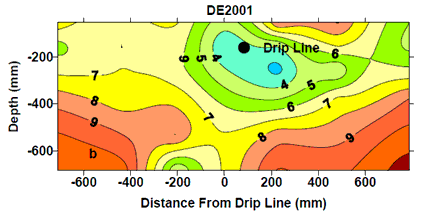
Figure 24. EC (dS/m) distribution for SDI of tomatoes (Hanson & May 2004)

